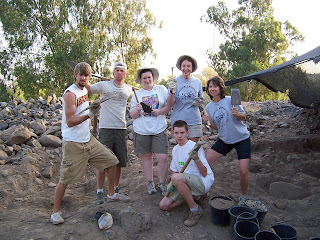Our group stayed at the Ginnesart Kibbutz on the Sea of Galilee. Yes, it was everything you might imagine it to be. The sights, scent, sounds and food provided vivid imagery of 1st century life in Israel. The wonderful thing about the Galilee is that little has changed scenery-wise from when Yeshua (Jesus) walked along the sea.
Every morning we would wake early to get our digging in before the summer sun became too uncomfortably hot to work. We would arrive at the site around 6AM. There were two sites you could choose from, one from 1000 BC around the time of David (the Kingdom of Geshur...the king was the father of one of David's wives) or the fishing village of Bethsaida from Yeshua's day. I chose Bethsaida! It was here that Yeshua healed the blind man with His spittle.
We used a small pick to loosen an area of dirt where we were working, transfer our dirt to a bucket which was then gently "sieved" and objects caught by the sieve were reserved. We would break for breakfast around 8:00 which included fresh Turkish coffee and then finished the day's work and headed back to the Kibbutz by noon. After a wonderful lunch in the hotel kitchen, we would get cleaned up and have a pottery reading at 4:00PM. Here our Archaeologist, Dr. Rami would "read" the pottery and other artifacts to identify our "finds". There was some pretty exciting stuff!
What was the most amazing thing is that as we sifted through the dirt, we would find remains from multiple centuries. The "finds" just at our site would include pottery shards from the 9-10th Century BC, cooking pots from the Roman era of Yeshua's (Jesus) day, pottery from Greece in 5 BC, an Islamic juglet jar from the 9th century AD, and a bullet from the 1967 war! Such a depth of history in one digging place.
Here is some of our crew at Bethsaida:
Pottery readings
I've been digging in another treasure trove recently called the Hebrew language. But believe me, I've only scratched the surface so far! I've not only been exploring the modern Hebrew but also unearthing the ancient Hebrew which is a picture language used by all Semitic people prior to 1200 BC. Why you might ask? That is a really good question.
First, it made sense that if I was going to study the scriptures from a Hebrew view point, I needed to know more about the Hebrew language. Beginning to explore this alone brought new understandings. For instance, in our English alphabet, the letter A or B doesn't mean anything in of itself. These letters are put together to form words that mean something. But in Hebrew, each letter means something and the AMAZING thing is, each letter in each word gives a fuller understanding of the word itself.
The Hebrew alphebet started out in the form of pictographs with each character representing a specific picture. Words were constructed by putting pictures together illustrating a characteristic of a word creating layers of rich understanding in every word. And the miraculous thing is that the modern Hebrew letters and words mean the same thing as the ancient picture language.
In English we read the text from left to right but in Hebrew the text is read from right to left.
For example, the Hebrew word for "sign" which first appears in Genesis 1:14 is "owt". In modern Hebrew it looks like this: ( aleph-vav-tav reading from right to left):
Tav (T) Vav (W) Aleph (silent)
Hebrew is spelled without vowels. Vowel sounds are added to the text with points.
Here is the word "owt" or "sign" in the ancient Hebrew picture language which Moses would have used (read from right to left):
Tav means sign, cross Vav means nail, Aleph means
covenant, seal to secure ox, strong leader
Put all together: "The strong leader is nailed or secured to the cross."
How much we miss when we read our Bible just in English and what a rich depth is uncovered when we examine the ancient Hebrew language!
We could conclude that God the Father really wanted us to "get" that His greatest sign would be One who was a strong leader nailed to a cross that would secure the covenant.
What an awesome God we serve!

Here are some great links to learn more:
livingwordpictures.com
ancient-hebrew.org
And for some great video series:
Mark Biltz at El Shaddai Ministreis gives a weekly presentation on each Hebrew letter. This link is to the study of Aleph, the first letter of the Hebrew alphabet.
http://elshaddaiministries.us/audio/hiddentreasures/20111128.html
Below is the beginning of a series on how the Hebrew language is found embedded in all of God's creation.











No comments:
Post a Comment